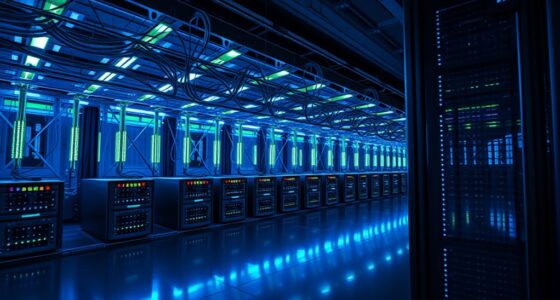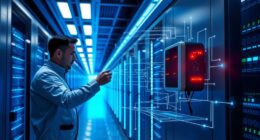Data gravity describes how large datasets tend to attract processing and storage closer to their source, making remote handling inefficient. To overcome this challenge, edge computing brings computing power directly to data sources like sensors and devices. This approach reduces latency, cuts bandwidth costs, and improves security by limiting data movement. By understanding how data gravity works, you can optimize your infrastructure. Keep exploring to discover how leveraging edge computing benefits different industries and applications.
Key Takeaways
- Data gravity causes large datasets to attract processing, making central data centers less efficient for handling massive data volumes.
- Edge computing decentralizes processing by bringing computation closer to data sources, reducing latency and bandwidth costs.
- Moving data locally enhances security, minimizes exposure, and supports real-time decision-making for applications like IoT and autonomous vehicles.
- Addressing data gravity with edge solutions improves system scalability, reduces network congestion, and lowers operational expenses.
- Strategically managing data gravity through edge computing optimizes data utilization, security, and overall organizational efficiency.

As organizations increasingly rely on vast amounts of data, understanding the concept of data gravity becomes essential. Data gravity refers to the tendency of large datasets to attract more data, applications, and services toward them. This phenomenon occurs because transferring massive amounts of data across networks is costly, time-consuming, and often impractical. As a result, the data itself becomes a central force, influencing where processing and storage should ideally occur. Instead of moving data to where resources are, the best strategy is to bring processing closer to the data itself, which is exactly what edge computing aims to achieve.
Data gravity drives large datasets to attract applications, making edge computing essential for efficient processing near data sources.
Edge computing decentralizes data processing by placing computational resources near the data sources—such as IoT devices, sensors, or local servers—reducing the need for data to travel to centralized data centers. When data gravity pulls data inward, it creates bottlenecks if you try to handle everything in a distant cloud or data center. Transferring large volumes of data introduces latency, increases bandwidth costs, and raises security concerns. By processing data locally, you minimize these issues, enabling faster decision-making and real-time insights critical for applications like autonomous vehicles, industrial automation, or smart cities.
You’ll find that edge computing helps businesses respond swiftly to changing conditions because it reduces dependency on remote data centers. Instead of waiting for data to traverse the network to a central cloud, computations happen right where the data is generated. This setup is especially advantageous when dealing with latency-sensitive tasks or when network connectivity is unreliable or limited. You’ll also notice that edge computing alleviates the load on core networks, conserving bandwidth and preventing congestion, which is crucial for maintaining smooth operations across distributed environments.
Furthermore, by processing data locally, you gain greater control over sensitive information. Instead of transmitting all data to a cloud, only relevant insights or aggregated results are sent, reducing exposure to potential breaches. This aligns well with privacy regulations and compliance standards. As organizations generate more data from IoT devices and sensors, the importance of managing data gravity through edge computing becomes clear. It ensures that the data’s natural pull doesn’t turn into a barrier but instead becomes a catalyst for more efficient, scalable, and secure data management.
In addition, understanding the cost implications of data transfer highlights the importance of edge computing, as reducing data movement can significantly lower operational expenses. You’ll find that understanding data gravity helps you recognize that moving data isn’t always the best solution. Instead, bringing processing closer to where data is created or collected allows you to optimize performance, reduce costs, and enhance security. Edge computing is the practical response to this challenge, enabling your organization to harness the full potential of your data without being hamstrung by its sheer volume or geographic distribution.
Frequently Asked Questions
How Does Data Gravity Influence Cloud Migration Strategies?
Data gravity makes you consider migration strategies carefully because large data sets tend to attract services and applications nearby, increasing latency and costs if moved to the cloud. To optimize performance, you might keep certain data and processing at the edge or within local data centers. This approach reduces data transfer, improves response times, and lowers cloud expenses, ensuring your migration aligns with data movement patterns and minimizes disruptions.
What Are the Main Challenges of Implementing Edge Computing?
They say “the devil is in the details,” and implementing edge computing presents plenty of them. You’ll face challenges like managing diverse hardware, ensuring data security, and maintaining reliable connectivity across remote locations. Additionally, deploying and scaling solutions can be complex, requiring expertise and careful planning. You need to balance cost, performance, and security, all while keeping your system flexible enough to adapt to rapidly changing demands.
How Does Data Security Differ at the Edge Versus Central Data Centers?
You need to know that data security at the edge differs from central data centers because it involves protecting data across numerous dispersed locations. At the edge, you face increased risks from physical access, device tampering, and inconsistent security measures. You must implement robust encryption, strong access controls, and continuous monitoring to safeguard sensitive information, as the decentralized nature makes maintaining uniform security standards more challenging compared to centralized data centers.
What Industries Benefit Most From Edge Computing Solutions?
You’ll find industries like manufacturing, healthcare, retail, and transportation benefit most from edge computing. In manufacturing, it enables real-time monitoring and automation, reducing downtime. Healthcare providers use it for instant patient data analysis, improving care. Retailers leverage it for faster transactions and inventory management. Transportation companies utilize it for real-time tracking and navigation. By processing data locally, these industries enhance efficiency, reduce latency, and improve decision-making in critical situations.
How Does Network Latency Affect Data Processing at the Edge?
Network latency can considerably slow down data processing at the edge, causing delays in real-time applications. When latency is high, data takes longer to travel between devices and servers, resulting in sluggish responses and decreased efficiency. You might experience lag in critical systems like autonomous vehicles or industrial automation. To minimize this, you need to optimize your network infrastructure, use faster connections, and process data locally whenever possible, ensuring smoother, faster operations.
Conclusion
As you embrace data gravity and edge computing, you’ll find that bringing processing closer to data boosts efficiency and reduces latency. Think of it like the Industrial Revolution—only now, your “steam engine” is cutting-edge technology. By harnessing these concepts, you stay ahead in the digital age, ensuring quicker insights and better decision-making. So, don’t get left in the dust—adapt now, or risk being the proverbial horse and buggy in a Tesla world.









